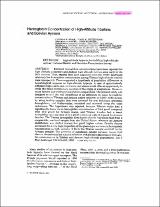Mostrar el registro sencillo del ítem
Hemoglobin concentration of high-altitude Tibetans and Bolivian Aymara
| dc.contributor.author | Beall, Cynthia M | |
| dc.contributor.author | Brittenham, Gary M | |
| dc.contributor.author | Strohl, Kingman P | |
| dc.contributor.author | Blangero, John | |
| dc.contributor.author | Williams-Blanguero, Sarah | |
| dc.contributor.author | Goldstein, Melvyn C | |
| dc.contributor.author | Decker, Michael J | |
| dc.contributor.author | Vargas, Enrique | |
| dc.contributor.author | Villena, Mercedes | |
| dc.contributor.author | Soria, Rudy | |
| dc.contributor.author | Alarcón, Ana María | |
| dc.contributor.author | Gonzales, Cristina | |
| dc.date.accessioned | 2020-11-17T18:01:23Z | |
| dc.date.available | 2020-11-17T18:01:23Z | |
| dc.date.issued | 1998 | |
| dc.identifier.uri | http://repositorio.umsa.bo/xmlui/handle/123456789/24462 | |
| dc.description.abstract | Abstract. Elevated hemoglobin concentrations have been reported for high-altitude sojourners and Andean high-altitude natives since early in the 20th century. Thus, reports that have appeared since the 1970s describing relatively low hemoglobin concentration among Tibetan high-altitude natives were unexpected. These suggested a hypothesis of population differences in hematological response to high-altitude hypoxia. A case of quantitatively different responses to one environmental stress would offer an opportunity to study the broad evolutionary question of the origin of adaptations. However, many factors may confound population comparisons. The present study was designed to test the null hypothesis of no difference in mean hemoglobin concentration of Tibetan and Aymara native residents at 3,800-4,065 meters by using healthy samples that were screened for iron deficiency, abnormal hemoglobins, and thalassemias, recruited and assessed using the same techniques. The hypothesis was rejected, because Tibetan males had a significantly lower mean hemoglobin concentration of 15.6 gm/dl compared with 19.2 gm/dl for Aymara males, and Tibetan females had a mean hemoglobin concentration of 14.2 gm/dl compared with 17.8 gm/dl for Aymara females. The Tibetan hemoglobin distribution closely resembled that from a comparable, sea-level sample from the United States, whereas the Aymara distribution was shifted toward 3-4 gm/dl higher values. Genetic factors accounted for a very high proportion of the phenotypic variance in hemoglobin concentration in both samples (0.86 in the Tibetan sample and 0.87 in the Aymara sample). The presence of significant genetic variance means that there is the potential for natural selection and genetic adaptation hemoglobin concentration in Tibetan and Aymara high-altitude populations. | es_ES |
| dc.language.iso | en | es_ES |
| dc.publisher | American Journal of Physical Anthropology | es_ES |
| dc.subject | HIPOXIA DE ALTA ALTITUD | es_ES |
| dc.subject | HEREDABILIDAD | es_ES |
| dc.subject | NATIVOS DE ALTA ALTITUD | es_ES |
| dc.title | Hemoglobin concentration of high-altitude Tibetans and Bolivian Aymara | es_ES |
| dc.type | Article | es_ES |

